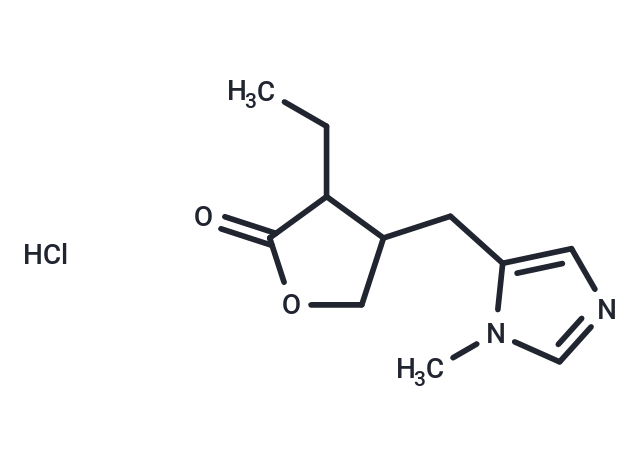Shopping Cart
Remove All Your shopping cart is currently empty
Your shopping cart is currently empty
Pilocarpine Hydrochloride (NSC 5746 HCl) is an M3-type muscarinic acetylcholine receptor agonist. Pilocarpine Hydrochloride was used to make an experimental model of epilepsy.

| Pack Size | Price | USA Warehouse | Global Warehouse | Quantity |
|---|---|---|---|---|
| 100 mg | $29 | In Stock | In Stock |
| Description | Pilocarpine Hydrochloride (NSC 5746 HCl) is an M3-type muscarinic acetylcholine receptor agonist. Pilocarpine Hydrochloride was used to make an experimental model of epilepsy. |
| Targets&IC50 | CYP2A6 (human liver microsomes):5.31μM, Pentoxyresorufin O-dealkylas (mouse liver microsomes):4 μM, testosterone 6 beta-hydroxylase (mouse liver microsomes):> 1 mM, Astrocytes:31.86 mM, Coumarin 7-hydroxylase (mouse liver microsomes):6 μM, dimethylnitrosamine N-demethylase (human liver microsomes):10 μM, coumarin 7-hydroxylase (human liver microsomes):6 μM, dimethylnitrosamine N-demethylase (mouse liver microsomes):100 μM, Testosterone 15 alpha-hydroxylase (mouse liver microsomes):6 μM |
| In vivo | METHODS: To study the effect of Pilocarpine Hydrochloride on salivary secretion, Pilocarpine Hydrochloride (0.5 mg/kg) was injected into rats. RESULTS: The salivary secretion volume of exercise group was significantly higher than that of control group (P<0.01). On the contrary, the Na+ concentration in saliva of the exercise group was significantly lower than that of the control group (P<0.05). [1] |
| Synonyms | Pilocarpine HCl, NSC 5746 HCl, (+)-Pilocarpine hydrochloride |
| Molecular Weight | 244.72 |
| Formula | C11H16N2O2·HCl |
| Cas No. | 54-71-7 |
| Smiles | Cl.CCC1C(Cc2cncn2C)COC1=O |
| Relative Density. | no data available |
| Color | White |
| Appearance | Solid |
| Storage | Powder: -20°C for 3 years | In solvent: -80°C for 1 year | Shipping with blue ice/Shipping at ambient temperature. | |||||||||||||||||||||||||||||||||||
| Solubility Information | H2O: 24.5 mg/mL (100.11 mM), Sonication is recommended. DMSO: 138 mg/mL (563.91 mM), Sonication is recommended. | |||||||||||||||||||||||||||||||||||
| In Vivo Formulation | 10% DMSO+40% PEG300+5% Tween 80+45% Saline: 4 mg/mL (16.35 mM), Sonication is recommended. Please add the solvents sequentially, clarifying the solution as much as possible before adding the next one. Dissolve by heating and/or sonication if necessary. Working solution is recommended to be prepared and used immediately. The formulation provided above is for reference purposes only. In vivo formulations may vary and should be modified based on specific experimental conditions. | |||||||||||||||||||||||||||||||||||
Solution Preparation Table | ||||||||||||||||||||||||||||||||||||
H2O/DMSO
| ||||||||||||||||||||||||||||||||||||
| Size | Quantity | Unit Price | Amount | Operation |
|---|

Copyright © 2015-2025 TargetMol Chemicals Inc. All Rights Reserved.